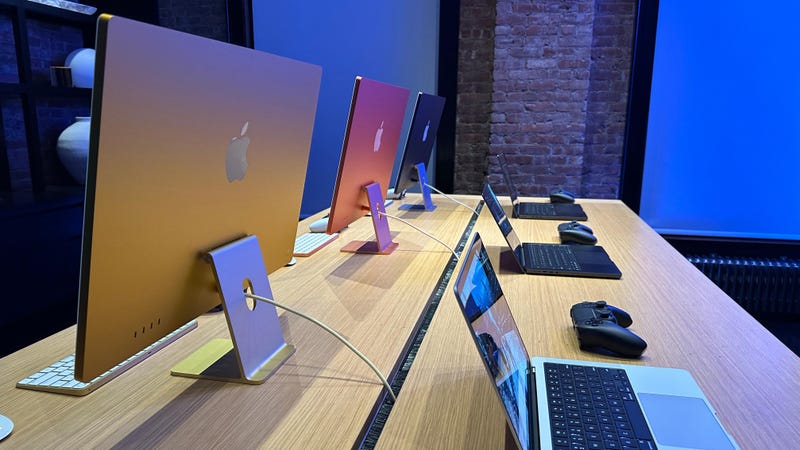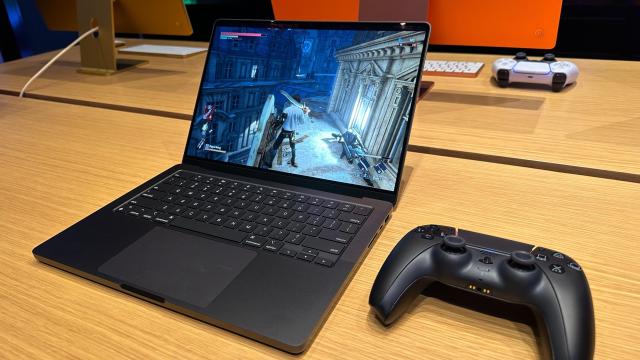Deep into the night before All Hallows Eve, Apple’s Cupertino spaceship headquarters was shrouded in a dense, black fog as if preparing to release a malevolent force upon the world. Thankfully, when the fog cleared, what we had instead was three new chips, a MacBook Pro update, and an iMac refresh.
The MacBook Pro now comes in an anodised Space Black that’s supposedly fingerprint-resilient. I won’t say it’s the most striking thing about Apple’s newest release, but damn. It does look nice. I did have the chance to put my grubby hands on the newest M3-powered MacBook Pros, and while I didn’t see many leftover smears on the surface, it didn’t take long for Apple staff to swoop in with microfiber cloth in hand to remove any wayward stains. All that is to say, the new M3 MacBook Pro sure does look the part.
Apple made it a point that the new M3 chip is a serious increase in power compared to any MacBook still running an Intel processor. It’s apparent the company’s tact isn’t necessarily to entice anybody still running an M2 or M1-based MacBook Pro but to get all those holdovers from the pre-M-series era to finally enter Apple’s walled garden of dark delights.
But the real question on everyone’s mind is: does the M3 truly change how you use a Mac? We’ve had over three years to get over the initial hype of the Apple-brand silicon, the M-series chips that now power all the company’s latest laptops and other PCs. Apple released the M2-powered 14- and 16-inch MacBook Pros earlier this year, and yet the newly revealed device set to launch next month starts at $US1,600.
In the few hours I spent using and seeing the new laptops in action, it’s hard to say whether the touted increased speeds are indeed as apparent as Apple wants to make it. Apple consistently claimed the M3 chip is 20 to 30% faster than the M2 chips and upwards of 50% better than the M1. But you already know the M-series MacBook Pro can handle most productivity tasks. Based merely on core specs, the M3 is a more powerful chip than the M2, but we need more time to put it through its paces.
Does the M3 MacBook Pro Work for Rendering and Gaming?

I saw the M3 Pro-powered MacBook running Photoshop tasks pretty smoothly, but that’s not necessarily new news if you’ve used the last-generation laptop. The M3 Max on the top end can have up to 128 GB of RAM, something that Apple is gearing toward folks who need a great deal of processing power. Apple showed me how it could run a 3D rendering program and animation simultaneously, and both took up around 90 GB of memory. Essentially, Apple is telling all the hardcore creatives out there they don’t need a full M1 Mac Studio to do some strenuous tasks.
In what seems like a new step for Apple, the company is really trying to hammer home the gaming potential for its laptop line. It’s been more than a decade since most folks—laypeople and techies alike—thought of the Mac as a gaming machine, but Apple dedicated an entire room to showing how some games fared on the company’s M3 Pro-powered MacBooks.
I saw Baldur’s Gate III running well on medium settings, but I couldn’t run it on higher settings. It was a similar story with another MacBook running Lies of P, which was also on medium to low settings. Otherwise, the company was showing off a few in-house benchmark demos and games like Myst, which few would consider a very demanding experience. The M3-powered iMac can play Stray on high settings if that really says anything about its overall gaming performance.
Oh, that’s right. There’s also a 24-inch M3-powered iMac. The iMac refresh made such little impact Apple barely dedicated more than two minutes during its presentation to its mainstay desktop PC. It’s the first we’ve seen of the device since 2021, but a few Apple fans were crossing their fingers to see a 32-inch iMac grace the scene—no such luck. The newest refresh isn’t all too refreshing, anyway. Despite the iPhone 15 finally switching to USB-C, the Magic Keyboard, Magic Mouse, and Magic Trackpad still use Lightning.
Apple Says Goodbye to The Touch Bar
One thing that did not make an appearance was the 13-inch MacBook Pro with Touch Bar keyboard, which started at $US1,300 for the M2-powered version, signaling the end of the divisive Touch Bar era. The base M3 MacBook model also only has 8 GB of RAM, which is a low starting point for any laptop, let alone one housing a faster CPU than its predecessors. You’ll have to spend $US2,000 to get the M3 Pro version with a base 18 GB of unified memory at 14 inches. The 16-inch Pro model only comes in M3 Pro and M3 Max flavors, starting at $US2,500 and $US3,500, respectively. Oh, and if you want that sleek black color, you’ll need to jump for the M3 Pro or M3 Max.
As noted by MacRumors, the new M3 Pro chip has 25% less memory bandwidth than the M1 and M2 Pro CPUs, a notable exception, but it could be a moot point depending on how well the new MacBooks do out in the field. Let’s hope we get a full year with these devices before ending up in Apple’s spooky graveyard like the ill-fated M2-powered MacBook Pros.
